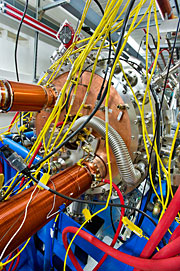- Number 361 |
- April 23, 2012
APEX: an electron gun for the next generation of light sources

The APEX electron gun.
APEX, the focus of the Advanced Photon Injector Experiment at DOE's Lawrence Berkeley National Laboratory, is an electron gun specifically designed for the front end of superconducting accelerators that will power the next generation of light sources based on free electron lasers, or FELs. FELs are undulators that wiggle electron bunches to produce pulses of coherent light. What makes APEX special is that it will continually produce well-shaped, ultrashort packages of electrons at rates of up to a million bunches per second.
FEL light sources are already online in Europe, Asia, and the U.S., chalking up research firsts by their unique combination of coherent light, broad tunability, and very high peak power. But compared to familiar synchrotron light sources they are tediously slow, with typical repetition rates in the hundreds or thousands of pulses per second. Some of the most interesting future science promised by FELs will explore how electrons move within molecules in close to real time, requiring very short x-ray pulses repeating hundreds of thousands or even a million times a second.
APEX applies unique technology to supply a high-quality electron beam at the high rep-rate needed to produce such short, fast-repeating pulses. Because high-repetition-rate x-ray beams call for superconducting electron accelerators operating at radio frequency (RF) in what’s known as continuous-wave mode (CW), the electron gun itself must operate at RF in CW mode. The catch is that high-frequency, high-power RF cavities operating in CW would melt.
Instead, APEX operates at VHF, which stands for “very high frequency” but is in fact very low frequency compared to the gigahertz RF of the accelerator itself. Thus the gun’s cavity can be considerably larger than that of high-frequency guns, with more surface area to distribute the heat and keep the gun cool while continuously accelerating electron bunches.
The other trick is a photocathode that can produce the bunches fast enough when stimulated by a dedicated laser. APEX is testing advanced photocathodes made of multi-alkali antimonides with high quantum efficiency, which can produce high-charge electron bunches at high rates. Because these compounds are extremely reactive, every trace of water, oxygen, and other contaminants must be sucked out of the high-vacuum gun.
Since the electrons created by the photocathode all have the same charge, they try mightily to push one another apart, an effect called space charge. The trick is to minimize the electrical fields each can feel without spreading them apart. If the bunches can be accelerated to high energy and very high velocity the moment they’re formed, Einstein’s Special Theory of Relativity comes to the rescue.
Approaching the speed of light, the electrons’ spherical fields start to flatten out – instead of a bunch of flying marbles they become a stack of flying pancakes. And since a moving electric charge generates a magnetic field, the fast-moving electrons generate strong, attractive magnetic forces that help hold the bunches together.
“With the kind of accelerator-based x-ray light sources we’re designing for, the quality of the electron beam is determined right when the electrons leave the gun,” says Fernando Sannibale of the Accelerator and Fusion Research Division (AFRD), who heads the APEX project. “We need tight electron bunches with high charge, high energy, and a very high repetition rate. And we need the gun to operate reliably over long periods.”
The APEX gun was conceived in 2006 by Sannibale and John Staples of AFRD and represents critical technology for the next generation of light sources. Initially funded under Berkeley Lab’s Laboratory Directed Research and Development program, since 2009 APEX has been supported by DOE’s Office of Science as part of a national program of research and development for accelerators and detectors.[Paul Preuss, 510-486-6249,
paul_preuss@lbl.gov]
